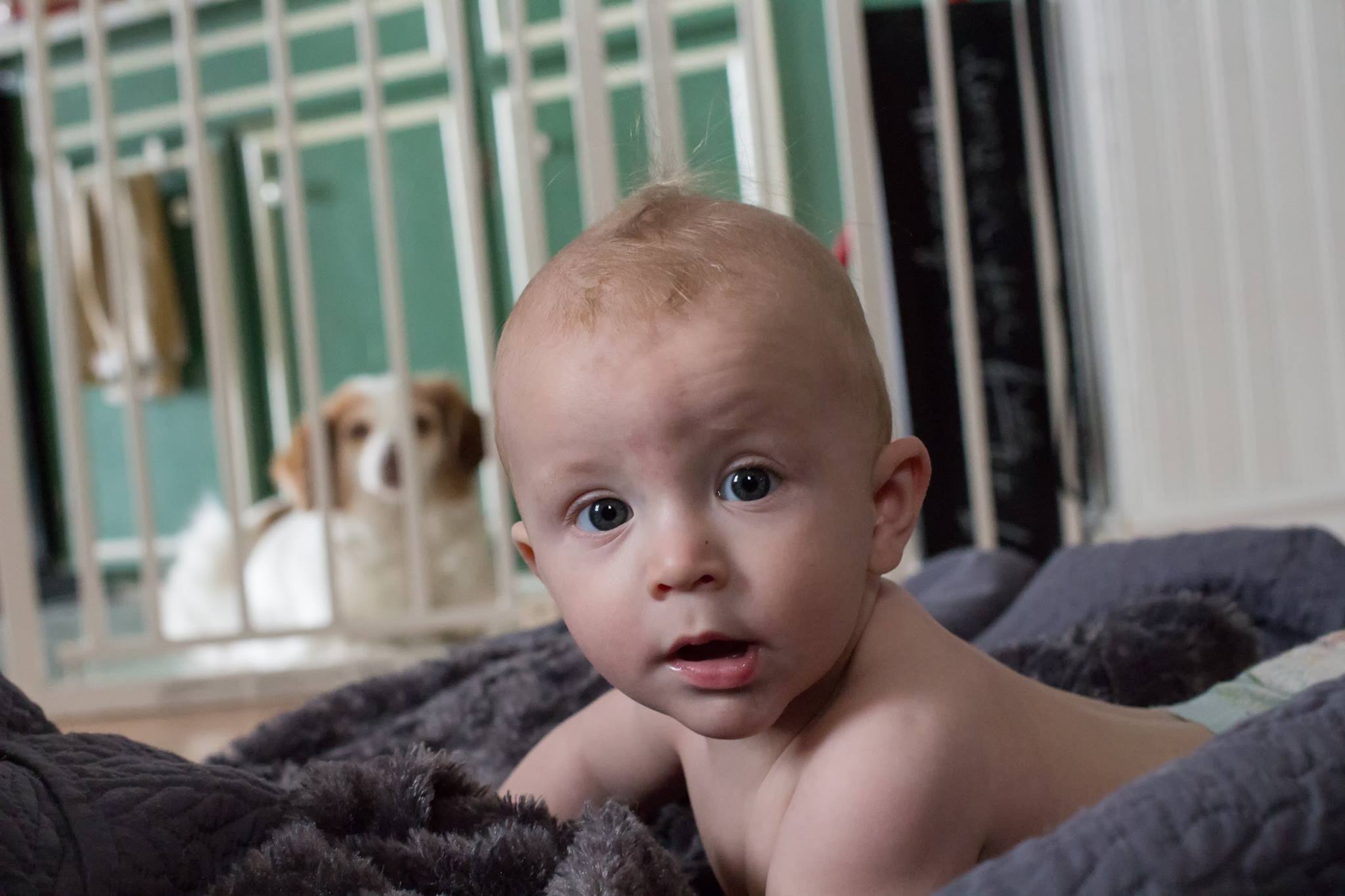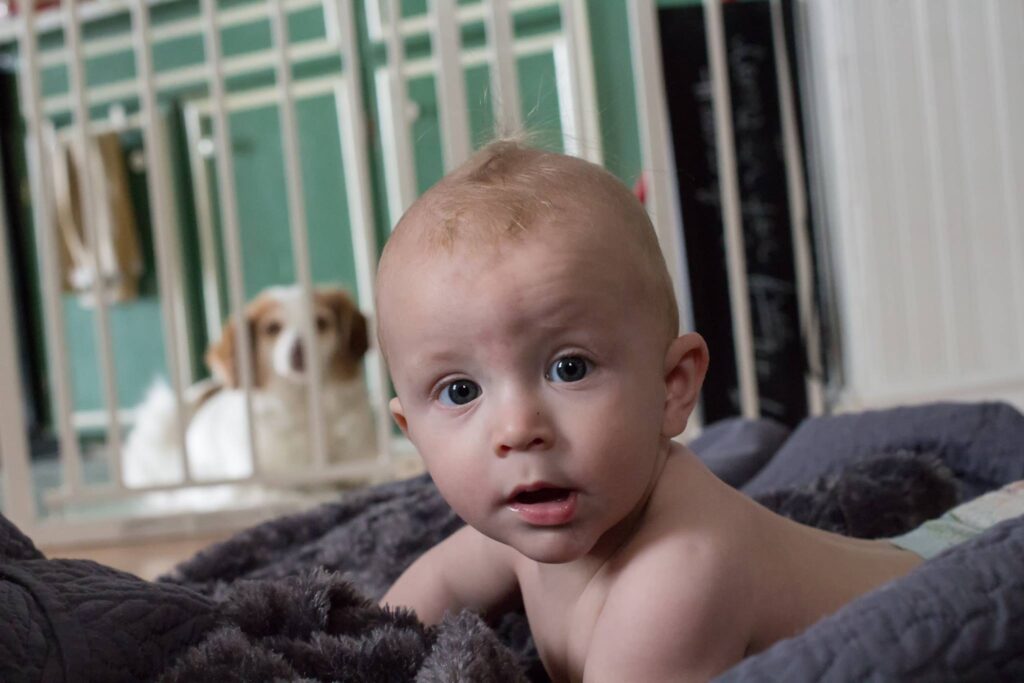1. Remember that you have a dog
You’re pregnant. Congratulations! You are about to become a mom – again! (Your fur baby totally counts – he/she is the older and wiser sibling, right?) Amongst the excitement, nerves, fear, doctors appointments, baby brain, and other stressors like moving, shopping, and preparing to take time off of work it’s easy to forget that this is a big change for Fido too. I often get calls from expecting mothers 2 weeks out from their due date who are suddenly realizing they have to prepare the dog! Their pup might not have polished manners, and they don’t know what to do with the baby toys that look like dog toys! New moms might not know how to introduce their baby to their dog. Pro tip: it shouldn’t be a big deal.
Even worse are the calls my colleagues and I get after the baby is home and the dog has already rough housed with, growled, snapped at, or bit the baby. So often, these incidents are preventable. I love helping expectant moms (and Dads, and Grandparents, and Aunts and Uncles) prepare so these incidents never happen in the first place.
2. Set Realistic, Healthy Expectations
Every new parent has a picture in their mind of what parenthood will be like. We imagine who our children will grow up to be, what activities we’ll do together, and in what ways our family members will support our child. Maybe you imagine your dog cuddling with your newborn, instant best friends. That’s a lot of pressure to put on yourself and your pup! Realistically – you are bringing a new and very strange thing into your household and disrupting your dog’s routine and living space. Babies look nothing like humans, and they grow and change rapidly. Just as your pup gets used to that blob that sleeps, eats, and cries that blob will be sitting up and interacting with the world. Shortly after that, the blob will be crawling and exploring with their hands – grabbing everything in sight. Yikes! It’s a lot for your pup to handle – especially in a NYC apartment. As New Yorkers, we have to get very creative with our space so that we can provide our pups with a space of their own to chill out and decompress from the chaos. When I am working with expectant families, we throw out the ideas of propping our newborn against the dog for photos and focus instead on helping our dog build a relationship with our newborn over time. We do this by setting up safe zones, allowing the pup space to relax safely away from the baby, and being an active part of all dog/baby interactions so that we can build positive associations and prevent the stress that leads to bites.
Many pup parents are sure that they will continue to give their pup the same level of love, attention, exercise, and mental stimulation post-baby that they did pre-baby. This is a wonderful goal, but remember – you will be exhausted & preoccupied with your new bundle of joy. This is normal, and you should bask in the glow. Even the most dedicated pet parents need support. Lose the guilt and hire a dog trainer to come in and give your pup some mental stimulation during the day, a dog walker for regular exercise, and employ neighbors and friends to come over and entertain the dog while you bond with your baby. Plan for this now.
3. Learn about dog body language & signs of stress
“But my friend just posted a photo of her dog and baby together and the dog was giving the baby kisses!” Yes, I know. The dog was licking the baby. But what may look like “kisses” to us is often a communication tool called “Kiss to Dismiss”, coined by FamilyPaws founder Jen Shyrock. Dogs do lots of things to tell us that they’re uncomfortable – the problem is that “dog body language 101” wasn’t an elective in school so we often miss when our dogs are saying “please stop” or “please leave me alone”. My pup is a kisser too, and I am one of those dog obsessed people that can’t get enough. He has at least 4 distinct kisses – an excited kiss, a loving kiss, a kiss that is on cue, and a kiss that says “please stop cuddling me now – let me go”. That last kiss is his own kiss to dismiss!
Most people recognize that a dog who is showing teeth, growling, barking, or biting is unhappy. But dog body language can be subtle – a body that’s a bit stiffer, an eye movement, a head turned away, and/or a furrowed brow can mean that your pup is uncomfortable and stressed out. When expectant parents learn to recognize these cues in their dog they feel empowered in their ability to help their dog feel safe and help their baby stay safe.

Dog behind gate watching Baby Crawl
4. Set up “success stations” in your house – places where your dog will be relaxed without access to the baby
Success Stations (I sometimes call them Safe zones) are designated areas where your dog is happy, relaxed, and where he/she is separated from the baby. Crates, baby gates, and tethers are your friend! If you are not actively engaged with both your dog and baby, they shouldn’t have access to each other.
I recommend starting with the following setup (at minimum):
- A baby gate for the doorway of the nursery, so your pup can see you but not participate (unless you are ready to actively supervise)
- A comfy crate that your pup is taught to love, where he always has something to do (stuffed Kong or Busy Buddy Twist & Treat or a Bully Stick are just two ideas)
- A comfy dog bed your pup is taught to settle on that can be easily moved from room to room, and a few tethers in predetermined locations
If your dog isn’t crate trained, whines or barks when separated from you behind a barrier, or has never learned to settle on a mat… now is the time to teach those skills.
5. Brush up on basic manners & resolve behavior issues
So many of our own parents tell us to expect the unexpected because parenthood isn’t something we can prepare for. While I know there is wisdom in those words, I also believe there is a great deal we can do to help ourselves succeed. Luckily, you probably already have an idea of what behaviors your pup might need to brush up on. Well… now’s the time! Does your pup know these skills? What about if you’re carrying a sack of potatoes? Walk around your house carrying a sack of potatoes to see if your pup responds to the following cues:
- Sit
- Down
- Stay
- Back Up
- Come
- Go To Mat
- Go To Crate
- Relax on Mat
- Loose Leash Walking
- How about Loose Leash Walking next to a stroller?
- Leave It?
- Drop It?
What about behavior issues? Does your dog bark at the doorbell or lunge at other dogs when out for a walk? Let’s tackle these problems together before the baby arrives.
If you’re reading this, you’re like me – you like to plan ahead. Here are some additional resources for expecting families:
- FamilyPaws – Webinars, Blog, DVD (I am a proud parent educator with Family Paws)
- Doggone Safe – Dog Bite Safety & Prevention Resources for families with Kids
- Living with Kids & Dogs, Colleen Pelar
- ParentingScience – Up to date, SOLID parenting advice from science. Sleep training? Attachment parenting? Feeding schedules? All here.
- Positive Parenting and Applied Behavior Analysis Online Course through University of North Texas

